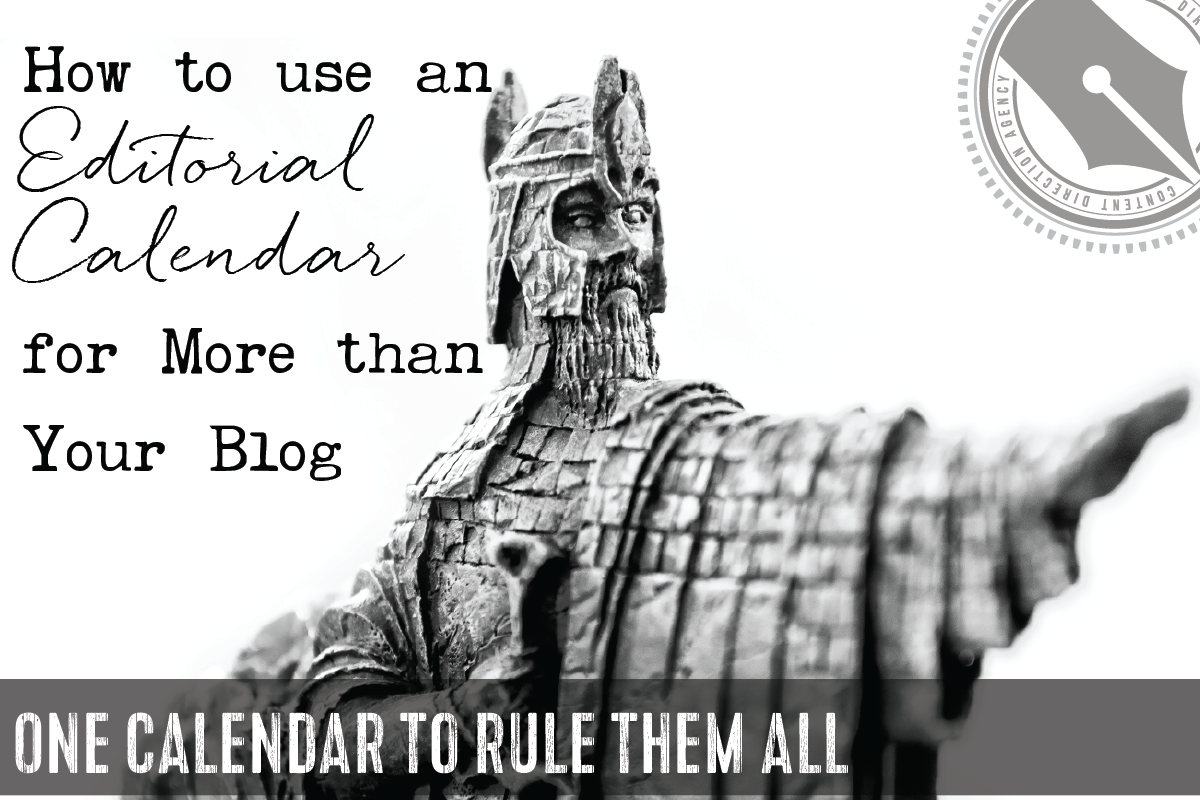One Calendar to rule them all,
One Calendar to find them,
One Calendar to bring them all
and in the darkness bind them.(With apologies to J.R.R. Tolkien)
If you’ve been following this blog for any time, you’ll be aware that I’m a big proponent of having an editorial calendar for your blog.
The short version is this: without a plan, you’re just wasting your time writing content that may or may not achieve your goals. WITH a plan, you can customize content to achieve your goals and have a much higher success actually achieving them.
Get it? Good. 😉
And, if you’re interested, you can grab the exact editorial calendar template I use with clients here. There’s even a video to show you how to use it.
But your editorial calendar can do so much more than organize your ideas, prevent writer’s block, engage different segments of your audience, and support your sales goals.
Think of it as your ONE CALENDAR TO RULE THEM ALL: if you need to write it, create it, email it, post it or tweet it, you need to schedule it.
Social media
When it comes to content marketing, your blog is the hub, but you may have many spokes of the wheel — Facebook, Twitter, Instagram, Tumblr, Periscope… And whatever comes next. You can easily use your editorial calendar to keep track of what you’re going to post to your various social media channels. Here are some ideas:
- Include Facebook updates, Tweets, and other promotional text right on your editorial calendar so that you and your team always know right where to find it. If you use my template, there’s a column already created for Facebook and Twitter updates.
- Create a separate tab (or space in your calendar) for planning social media updates. One great idea I saw suggested curating your updates each week around a theme that compliments your weekly blog post.
- You might also want to keep track of other places you’re sharing and promoting your post, like Facebook or LinkedIn groups.
Newsletters
If you communicate with your customers via email (you do, right?) you can use your editorial calendar to keep track of your newsletters as well.
- If you have to write it, put it in your calendar! Put your newsletters in a different color than your blog posts and use the calendar to plan out what you’re going to write (and why).
- If you’re doing additional sales emails (beyond your regular communications) add those to your editorial calendar as well.
- Use the “Who” section of your editorial calendar if you’re sending out emails to different segments of your audience.
- Especially when you’re planning a launch, it’s great to see all your emails, blog posts, etc. that support the launch in one place.
Publicity and Outreach
A great way to use your calendar is to keep track of your media outreach and guest posting opportunities.
- If you have to write it, put it in your calendar! I suggest putting guest posts in another color on your calendar so you can easily see them at a glance.
- I keep a separate tab in my editorial calendar spreadsheet for potential guest posting opportunities. I keep track of the website, the contact info, submission guidelines, pitch ideas, and the status of my pitch. I also use it when I’m ranking which guest posting opportunities to pursue first.
- Your editorial calendar spreadsheet or social media calendar is a great place to keep track of social influencers and other bigwigs you want to connect with. Add something like, “Tweet with Bigwig B” to your social media calendar to remind you to cultivate the connection.
- Remember to promote your appearances on other sites to your own list as well — schedule it in your calendar!
Affiliate Marketing
If you do any affiliate marketing, participate in telesummits, or do webinars or other joint venture projects, you need to keep track of your commitments to make the most of each opportunity.
- IF YOU HAVE TO WRITE IT — oh, you know the rest. 😉
- Include solo emails in your editorial calendar the way you would newsletters.
- Include any guest posts you need to write for JV partners.
- Include social media updates to promote your affiliate sales and JV partnerships.
- You can also include deadlines for other collateral you need to provide, like interview questions, your bio, or bonuses you need to create.
Metrics Tracking
Finally, not exactly a component of planning, but definitely a component of content marketing, you can use your editorial calendar to track the metrics you use to determine if your marketing efforts are working.
- In a spreadsheet format like mine, include a column to track how many likes, comments, retweets, opt-ins or hits your post receives. (Choose what to track based on your goals.)
- You can use this information to choose which posts to promote again on social media, and which to repurpose.
- If you like having things all in one place (like I do) you can also dedicate a tab in your spreadsheet to other important metrics you want to track.
Unlike the One Ring, your editorial calendar is a force for good! But don’t be surprised if you start referring to it as your “precious” once you get it all organized.
And if you’re still not totally sure how to make this all work, don’t fret, I have good news for you:
- You can use my editorial calendar template to help you get started. It’s a low-tech spreadsheet, but it totally gets the job done!
- I’ve also got a really nice free ebook that walks you through the theory behind my editorial calendar system that you can grab in our free resource library.
- In a few weeks, I’ll be sharing a post about the OTHER tools you can use to create a comprehensive editorial calendar. So stay tuned!

